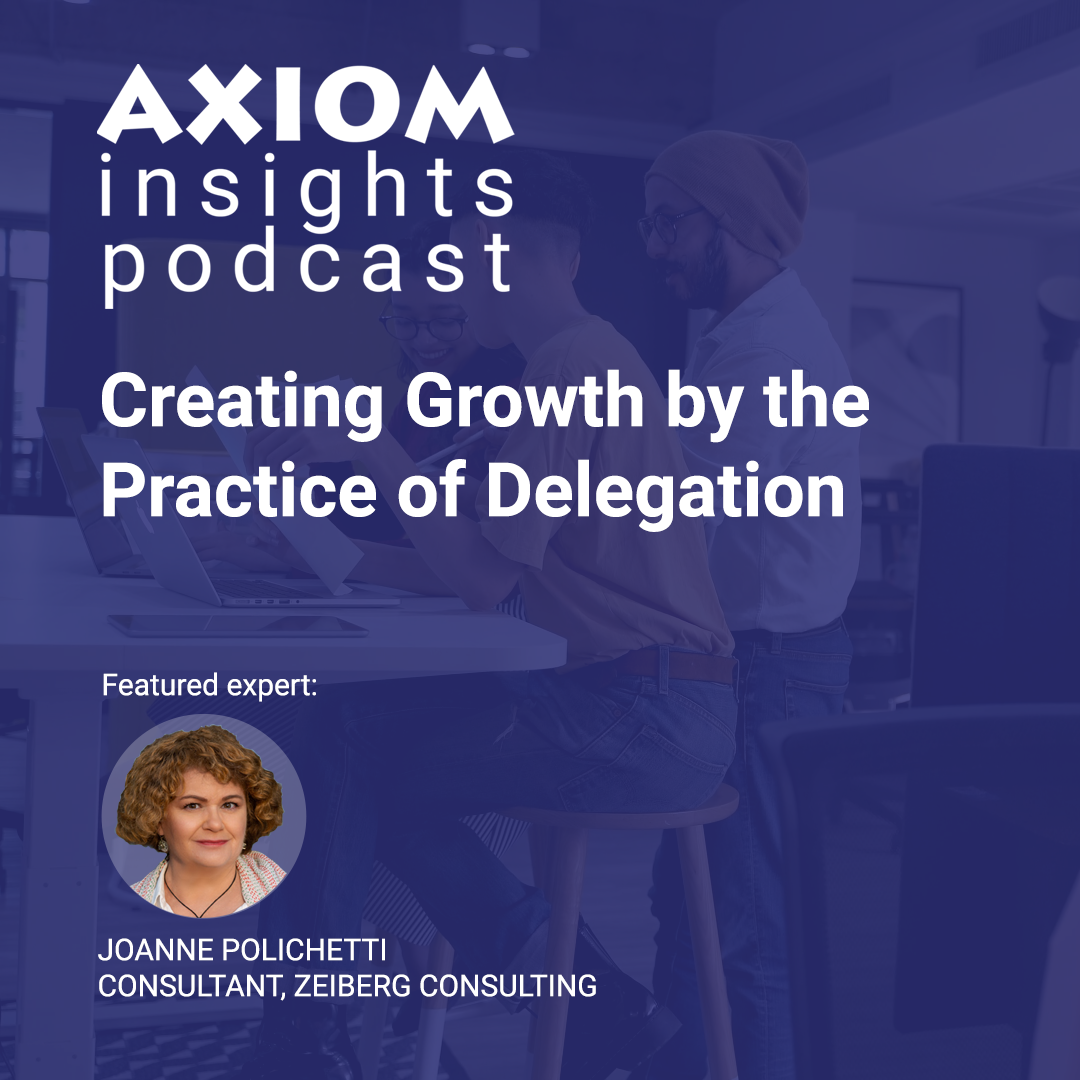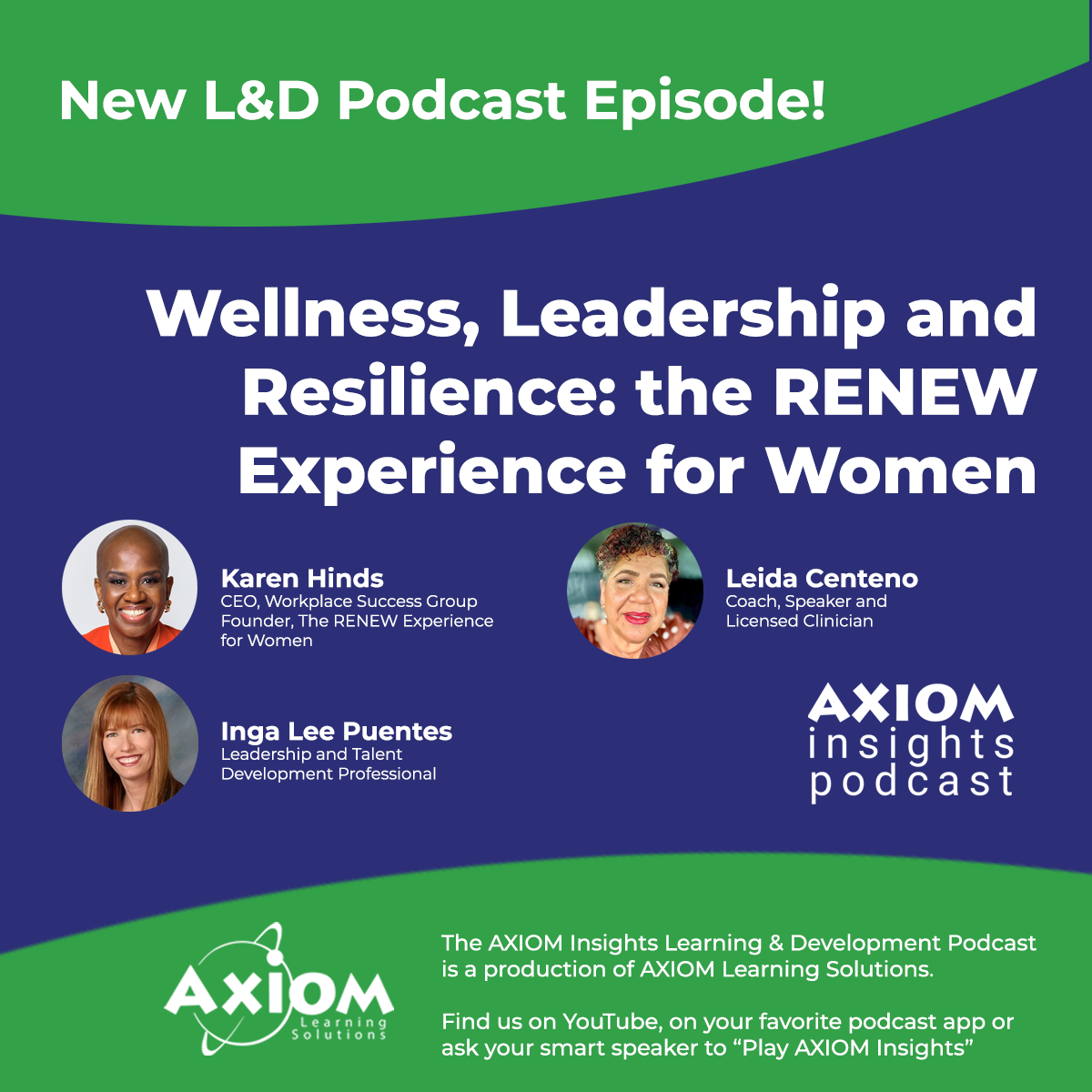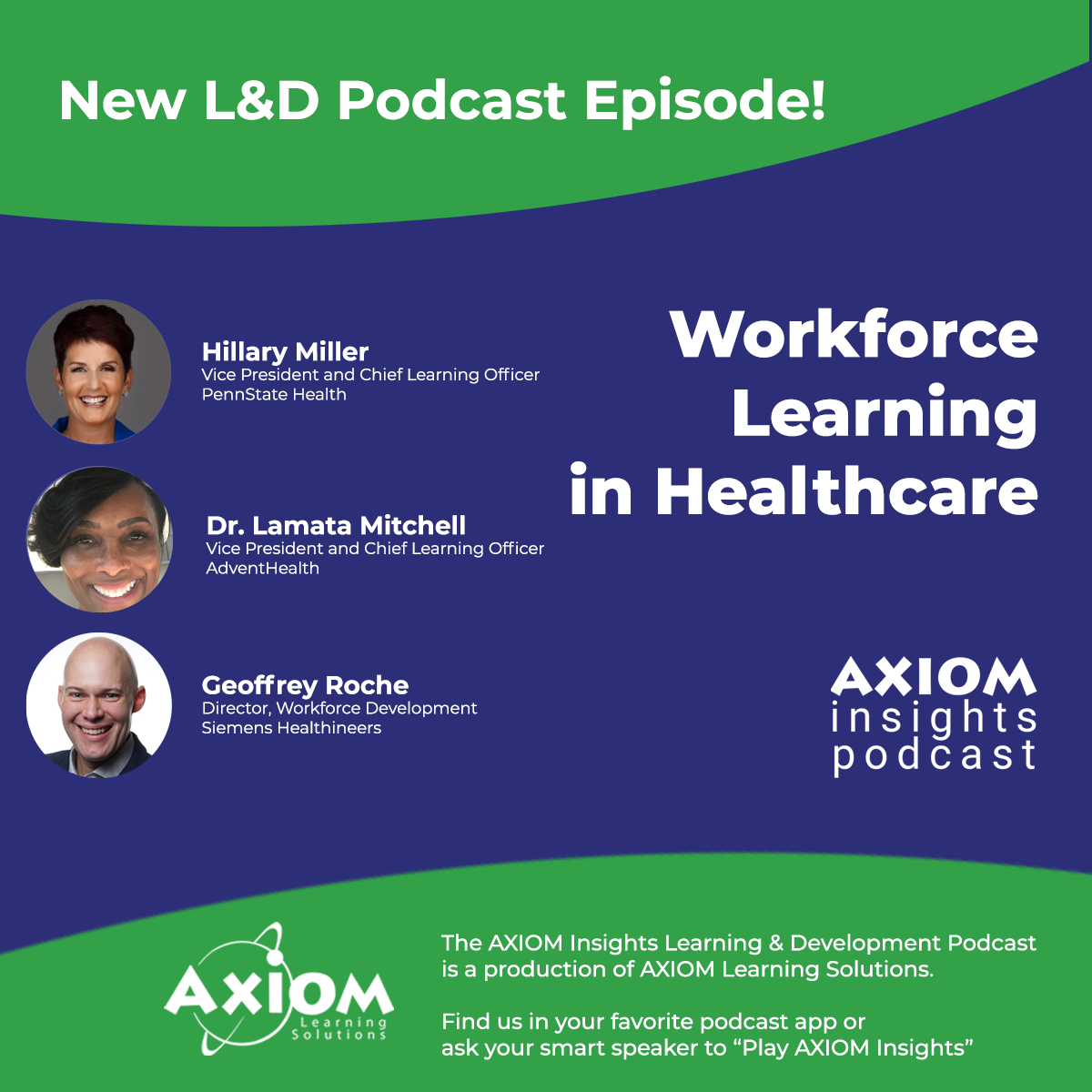Episode Transcript
Scott Rutherford: Hello and welcome to the AXIOM Insights Learning and Development Podcast. In this podcast series, we focus on driving performance through learning. And in this episode, we're going to be answering really one question: What do you do if you need to set up a learning function from scratch, from a blank sheet of paper?
We'll talk through a few examples of what that looks like. But to dig into this, I'm joined by Jenessa Dowe Jacobs. Jenessa is an executive and L&D strategist, an author, a keynote speaker. She specializes in the creation and design of the learning function in organizations from moment one. So, hi Jenessa, and thanks for being here.
Jenessa Dowe Jacobs: Hey, thanks so much for having me. I'm excited to talk today.
Scott Rutherford: So let's start off, if you don't mind, by just getting to know you a little better. How did you first get involved in L&D as a profession? Talk us through briefly from moment one to where we are today.
Jenessa Dowe Jacobs: Yeah. So my journey into learning and development was never really about chasing a specific job title or even following specific patterns. Very early in my career, I was in roles tied to operations, billing, and analytics. And I kept seeing the same things—trends and breakdowns that happened not because people were bad at their jobs, but because the systems weren't clear, the tools didn’t support the work, and people didn't have the training they needed.
That pulled me toward L&D. I realized that if I could help fix those things—the people, the processes, and the products—I could help an entire business run better.
That led me to be the person companies bring in when learning and development departments need to be rebuilt. I worked across multiple industries: healthcare, property management, distribution, manufacturing, large beverage manufacturing, sales, gyms, and fitness. In every role, the pattern has been the same: assess where the friction is, and build systems that make skills scalable, sustainable, and aligned to business goals.
Once the infrastructure is in place and automated, we can optimize and really do what the business needs. Looking back every two to three years, I've been able to build out a fully functioning L&D department and create long-term value through repeatable systems, not just content.
What excites me most is empowering organizations not only to own learning as a capability, but to grow individuals.
Scott Rutherford: Yeah, I want to focus a little on the nature of the structure of the learning organization. I think sometimes in business, there's a tendency to say, well, I'm in consumer packaged goods, or I'm in professional services, or I'm in whatever, and so my structure and my needs are going to be wholly different and I need to reinvent the wheel.
It's a leading question, but it seems to me there’s more similarity than difference. We talk about this in the CBTM curriculum, for example, in terms of the high-level models of learning structure. But I'm curious to hear your perspective on building an enterprise-wide learning platform—how do you approach the arc of that project, from needs assessment through fulfillment? Could you give me an example?
Jenessa Dowe Jacobs: Absolutely. No two companies are the same, but the infrastructure underneath a successful learning function often is. I always start by assessing the three Ps: the people doing the work, the processes they’re expected to follow, and the products and tools they’re using. Across industries, I’ve found shocking similarities.
One example: when I transitioned from healthcare to property management, on paper those organizations couldn’t be more different. But structurally, the same issues showed up. In healthcare, you had nurses, therapists, and doctors documenting and delivering care with inconsistent systems and no centralized learning. In property management, it was field technicians, management teams, and call centers doing the exact same thing—solving urgent problems, training themselves and others, holding the system together with a lack of resources and the best intentions.
Both environments were decentralized, with people creating thousands of training materials on their own just to get through the day. It was chaotic, unsustainable, and burnout was high. Roles weren’t clearly defined, onboarding was inconsistent, performance was hard to measure, and retention was an uphill battle.
So I built infrastructure. We created centralized repositories, but also gave SMEs and frontline experts structured ways to contribute. Too often, L&D comes in and says, “Stop everything so we can sort through it all.” But that doesn’t stop frontline workers from creating training materials—they’ll keep doing it, just without telling you.
Instead, we created funnels with approval workflows, defined ownership, aligned content creation, and matched it to business needs. That way we reduce noise while scaling learning. Because while people and products may change from company to company, the infrastructure that supports sustainable learning doesn’t. If you build for clarity, consistency, and contribution, you can scale anywhere.
Scott Rutherford: I like what you’re saying. On day one, you want to intentionally be an enabler, not an obstacle. Often when consultants or outsiders come in, the existing organization pushes back against the irritant. So, as you said, it’s important to embrace the necessary “keep the lights on” efforts while advocating for something better.
Jenessa Dowe Jacobs: That’s absolutely right. One of the first things I do is pay attention to the language people use. Naming conventions tell you everything about alignment, communication, and silos. If two teams are working on the same process but calling it two different things, there’s a disconnect—not just in terminology, but in understanding, execution, and even how they feel about their work.
You can’t build a learning system on confusion. So before diving into content gaps or platforms, I listen closely to language and naming conventions. That tells me about the culture, the informal structures, and where breakdowns are happening.
Scott Rutherford: Right. The backchannel conversations—who knows what, who knows who. Sometimes people are doing very similar work in silos they didn’t even know existed. Surfacing that is important.
So once you have a handle on strategic learning needs, what’s next? You’ve talked about people, processes, and systems, but that scope can expand quickly. How do you put boundaries around it?
Jenessa Dowe Jacobs: The truth is, most organizations already have what they need—it’s just not organized. It exists as tribal knowledge, workarounds, spreadsheets, informal mentorship, or even a folder named “training guides” on someone’s desktop that no one else has ever seen. If that knowledge exists, the business is functioning. If it doesn’t, you’ve likely been brought in as a last-ditch effort and leadership may already be planning to cut their losses.
Once strategic needs are identified, it’s about clarity and alignment. I return to the three Ps: people (are they in the right roles with authority and clarity?), process (can the work flow without detours and band-aid fixes?), and products (do the tools support the process or create noise and duplication?).
I look for “stops”—where the workflow feels unnatural, where things pause, escalate, or cause confusion. Those stops tell me where to intervene. Think of it like driving a car: you need a driver, a car, and fuel. If one of those isn’t working, I need to identify whether we need a mechanic, a gas pump, or a mental health check-in for the driver.
Scott Rutherford: Let’s talk about navigating hierarchy in large, complex companies. Perceptions of learning vary between the C-suite and the frontline. Often you’re brought in by a director or senior leader who sees a need from their perspective. But you also need executive sanction, resources, and staff buy-in. How do you approach the politics of that?
Jenessa Dowe Jacobs: Politics really is a fourth “P.” It’s one of the biggest challenges. Many organizations see training as an intervention—something you plug in when someone underperforms—rather than integration into habits and systems.
Another challenge is stakeholder alignment. Everyone says they want the same outcomes—better performance, stronger onboarding, leadership development—but each has a slightly different agenda. Rarely are visions as aligned as people think, because of communication breakdowns and varied experience.
That’s why I always say you don’t need 10 to 20 aligned executives to start. You need three great stakeholders: a witness, an accomplice, and an alibi.
• The witness sees gaps clearly, speaks to pain points others may ignore, and helps you build the case for change.
• The accomplice is your partner who gives you access, pulls resources, and tests ideas with you—sometimes under the radar—so you can prove value.
• The alibi is a senior leader who protects the space for the work. When others push back, they say, “No, this is important. Let them work.”
Scott Rutherford: I like that framework. From there, how do you think about learning culture? Can it exist in organizations without a formal structure?
Jenessa Dowe Jacobs: Absolutely. Learning culture exists even without a formal function. It shows up in small things: how people share knowledge informally, whether it’s safe to ask questions, how teams support new members. But without structure, that goodwill-based culture eventually leads to burnout.
I use Jim Collins’ Hedgehog Concept: the intersection of what people are passionate about, what drives the economic engine, and what they can be best at. Applied to learning:
• Passion: what do people love to learn about?
• Economic engine: how does learning move the needle for the business?
• Greatness: what can the organization be best at, including how it teaches and supports people?
Learning culture thrives when those three intersect. My role isn’t to impose culture—it already exists—it’s to connect it to strategy and reinforce it with the right people, processes, and products. That’s when learning stops feeling like an “extra” and becomes part of how the organization thrives.
Scott Rutherford: Let’s shift to outcomes and measurement. In a new learning function, you often have to convince decision makers that if we do this, better things will happen. How do you sell the future benefit and set up the learning structure for success?
Jenessa Dowe Jacobs: Nothing scalable happens without senior leadership support. Early on, I focus on listening and identifying business concerns—retention, revenue, compliance, speed to proficiency. Then I link learning to those outcomes quickly.
Instead of launching a massive initiative, I look for small, quick wins aligned to leadership priorities. Maybe fixing one piece of onboarding or helping reduce turnover on a key team. These are “trust drips”—small, consistent actions that build credibility over time.
I show up with metrics that matter, celebrate wins, involve leaders, and stay transparent when something doesn’t work. Over time, those trust drips compound. Leaders stop seeing you as “the training person” and start seeing you as a strategic partner.
Every leader wants learning; they just don’t always use that word. My job is to speak their language, not mine.
Scott Rutherford: Exactly. The business world doesn’t use learning jargon, and that’s an easy point of conflict. What I like is that you frame success in the stakeholder’s own language and then show how learning drives the metrics they care about.
Jenessa Dowe Jacobs: Right. Rarely does leadership ask about course completion rates. What they care about is whether learning has been applied, and what that means for risk, revenue, costs, and people’s lives.
Scott Rutherford: Which ties back to the blank-sheet approach. If you’re not hampered by legacy decisions, you can build systems that make your organization more competitive than peers. Have you seen companies embrace that idea?
Jenessa Dowe Jacobs: Yes. I’ve worked with two organizations that said, “We’re starting from scratch.” One was launching a new business unit, another was introducing new technology. In both cases, expectations were twofold: build infrastructure and create momentum.
Often there’s no baseline data because training was inconsistent, undocumented, or nonexistent. My first job is to define constraints, then create a framework with freedom within it. Define what good looks like in onboarding, performance, leadership. Create systems to track and reinforce it.
People will always learn and grow—that’s constant. Our role is to shape and guide that growth in alignment with business goals.
Scott Rutherford: In today’s environment, we can’t ignore AI. Generative AI, agentic AI, AI-enabled browsers—it’s everywhere. How do you advise organizations on integrating these tools without just chasing shiny objects?
Jenessa Dowe Jacobs: I love AI. It’s changing the learning landscape, but it doesn’t replace people. The more advanced AI becomes, the more important humans are in shaping how it’s used. Learning is about discernment, ethics, and context.
I think about learning in three levels:
1. Basic knowledge transfer—static, non-variable information. AI is great here.
2. Introducing variables—real-world conditions and nuance. AI struggles because it lacks discernment. Humans must decide whether it’s learning or hallucination, and align with values and ethics.
3. Mentorship—developing people to coach and guide others. This is where L&D can lead. AI automates the busy work—content formatting, information retrieval—giving L&D professionals time to focus on humans.
Scott Rutherford: I love that you keep it learner-centric. Before we wrap up, how long should organizations expect a rebuild to take?
Jenessa Dowe Jacobs: It depends on alignment. I’ve seen it done in six months with unlimited budget, the right people, and strong buy-in. I’ve also seen it take two years because stakeholders weren’t aligned with each other. Alignment is either the biggest enabler or the biggest barrier.
Scott Rutherford: Exactly. Sometimes politics and history slow things down. But when you get alignment, everything flows.
Jenessa, thank you for being here. This has been a fun conversation.
Jenessa Dowe Jacobs: Thank you so much for having me.
Podcast Narrator: This has been the AXIOM Insights Learning and Development Podcast. This podcast is a production of AXIOM Learning Solutions. AXIOM is a learning and development services firm with a network of learning professionals in the US and worldwide, supporting L&D teams with staff augmentation and project support for instructional design, content management, content creation, and more, including training delivery and facilitation, both in person and virtually.
To learn more about how AXIOM can help you and your team achieve your learning goals, visit axiomlearningsolutions.com. Thanks again for listening to the AXIOM Insights Learning and Development Podcast.


